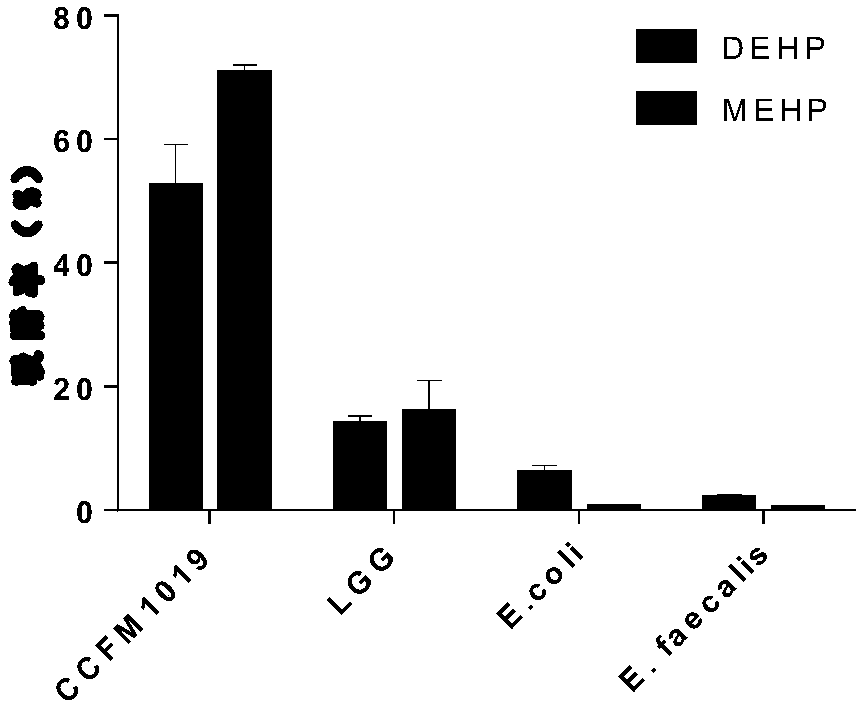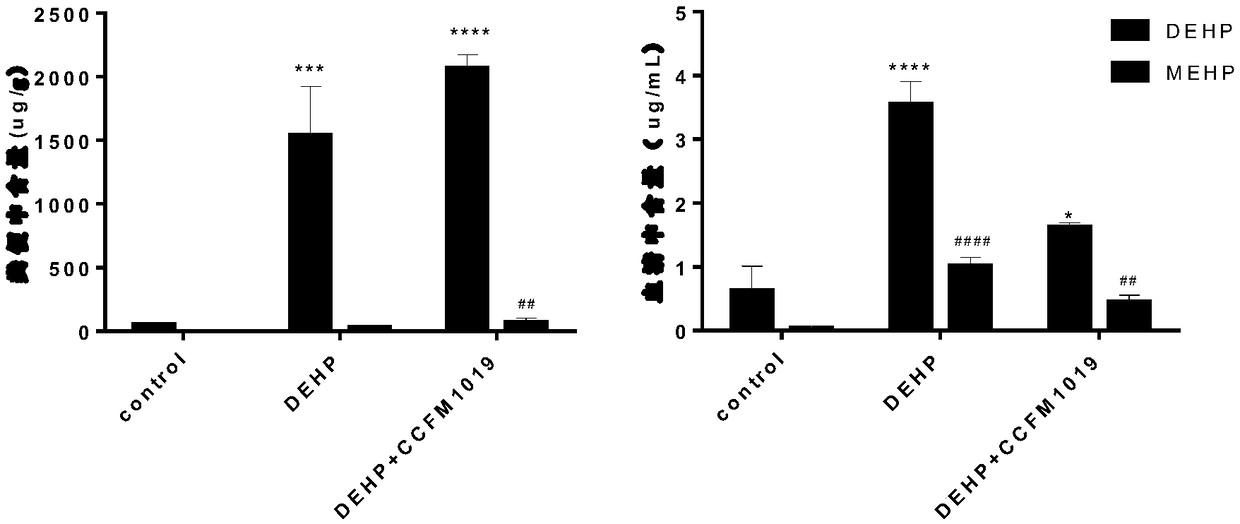Lactobacillus plantarum CCFM1019, fermented food and application to preparation of drug
A technology of CCFM1019 and Lactobacillus plantarum, applied in the field of microorganisms, can solve problems such as unsatisfactory adsorption effect, achieve good gastric acid resistance and bile salt resistance, reduce damage, and promote discharge
- Summary
- Abstract
- Description
- Claims
- Application Information
AI Technical Summary
Problems solved by technology
Method used
Image
Examples
Embodiment 1
[0068] Example 1: Lactobacillus plantarum CCFM1019 has good tolerance to simulated gastrointestinal fluid
[0069] The cryopreserved Lactobacillus plantarum CCFM1019 was streak-inoculated in the MRS solid medium, and cultured aerobically at 37°C for 24 hours, and then subcultured in the MRS medium for 2 to 3 times, then the culture medium of Lactobacillus plantarum CCFM1019 was taken, The bacteria were collected by centrifugation at 8000×g for 5 min, resuspended in (1:1) artificial simulated gastric juice of pH 2.5 (MRS medium containing 1% pepsin, pH=2.5), and then cultured aerobically at 37°C. Samples were taken at the beginning (0h), 1h, 2h and 3h, and MRS agar medium was used to pour culture for plate colony counting, and the number of viable bacteria was determined and the survival rate was calculated. The survival rate is the ratio of the number of viable bacteria in the culture medium to the number of viable bacteria at 0h, expressed in %.
[0070] Take the culture sol...
Embodiment 2
[0075] Example 2: Lactobacillus plantarum CCFM1019 has good adsorption capacity for DEHP and MEHP in an aqueous solution containing plasticizer DEHP or MEHP in vitro
[0076] Bacteria adsorption: After the experimental bacteria were purified and activated, they were inserted into the MRS liquid medium according to the inoculation amount of 1% (v / v), and cultured at 37°C for 20h (E.coli uses LB culture based on shaking culture at 37°C; E. .faecalis is cultured in MRS based on 37°C), then centrifuged at 8000×g for 20 minutes, poured off the supernatant, resuspended with ultrapure water, continued to centrifuge at 8000×g for 20 minutes, and poured off the supernatant Live bacteria cells, that is, wet bacteria. The wet bacteria were resuspended in 50mg / LDEHP or 10mg / L MEHP aqueous solution, and the final bacterial concentration reached 1g wet bacteria / L, and the blank control was wet bacteria resuspended in ultrapure water without DEHP and MEHP. The volume of each group is 1 mL. ...
Embodiment 3
[0083] Example 3: Lactobacillus plantarum CCFM1019 has no acute toxic side effects on SD rats
[0084] Lactobacillus plantarum CCFM1019 was resuspended in 2% (w / v) sucrose solution, and the cell density was 1.0×10 9 CFU / mL. Take 10 healthy male SD rats with a body weight of about 100 g, and give 2 mL of the suspension solution of this concentration by intragastric administration every day, observe for a week, and record the death and body weight.
[0085] The results of these tests are listed in Table 4. The results showed that the feeding concentration of 1.0×10 9 CFU / mL of Lactobacillus plantarum CCFM1019 had no significant impact on rats, no significant change in body weight, and no death. The appearance of the rats showed no obvious pathological symptoms.
[0086] Table 4 Changes in body weight and death of rats
[0087]
[0088] Note: -: Rats did not die
PUM
 Login to View More
Login to View More Abstract
Description
Claims
Application Information
 Login to View More
Login to View More - R&D
- Intellectual Property
- Life Sciences
- Materials
- Tech Scout
- Unparalleled Data Quality
- Higher Quality Content
- 60% Fewer Hallucinations
Browse by: Latest US Patents, China's latest patents, Technical Efficacy Thesaurus, Application Domain, Technology Topic, Popular Technical Reports.
© 2025 PatSnap. All rights reserved.Legal|Privacy policy|Modern Slavery Act Transparency Statement|Sitemap|About US| Contact US: help@patsnap.com



